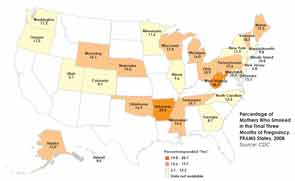
A billion adults worldwide smoke tobacco, and, according to World Health Organization estimates, their numbers are growing. Six million people die annually from the tobacco habit, and that number is projected to exceed eight million by 2030.
Explore This Issue
October 2013In the United States alone, 43.8 million people still smoke, despite aggressive anti-tobacco campaigns waged by multiple private and government-sponsored organizations over the past several decades. Data from the Centers for Disease Control and Prevention (CDC) suggest that 21.6 percent of men and 16.5 percent of women in the U.S. smoke. Many of those women are in their childbearing years. The Pregnancy Risk Assessment Monitoring System, which monitors changes in maternal and child health indicators in 29 states, puts the overall prevalence of maternal smoking during the last three months of pregnancy at 12.8 percent in the participating states, ranging from a low of 5.1 percent in Utah to 28.7 percent in West Virginia (see map, below).
The list of health hazards associated with smoking continues to grow. According to the CDC, babies born to women who smoke while pregnant have a higher risk of premature birth and low birth weight and an increased risk of sudden infant death syndrome (SIDS), cleft lip or palate, asthma, obesity and cognitive deficits, among other injuries. Now, a new study suggests that hearing loss should be added to this list.

Source: CDC
Setting the Stage
The new findings follow earlier research by the same investigators showing an association between sensorineural hearing loss (SNHL) in adolescents and secondhand smoke (SHS) exposure (Arch Otolaryngol Head Neck Surg. 2011;137:655-662). In that study, the authors referred to data linking prenatal or childhood SHS exposure to numerous health problems including SIDS, asthma and other respiratory tract disorders, and cognitive and behavioral problems, as well as an increased risk of otitis media. The authors also cited evidence that more than 50 percent of adolescents in the United States are exposed to SHS. They hypothesized that secondhand smoke may also have the potential to impact auditory development, leading to SNHL because of its negative effects on in utero development, low birth weight, direct damage to cranial nerve VIII, or brain damage secondary to childhood and adolescent exposure. They tested that hypothesis in a study of young people 12 to 19 years of age.
Leave a Reply